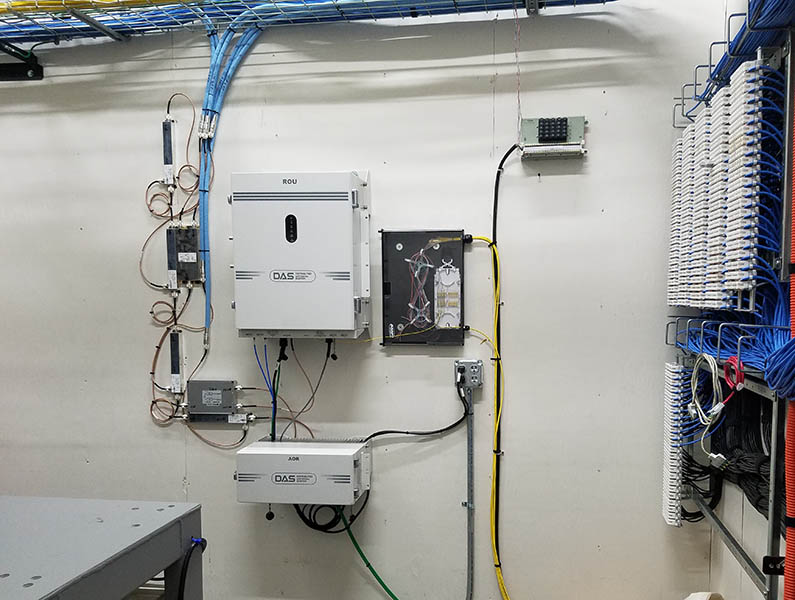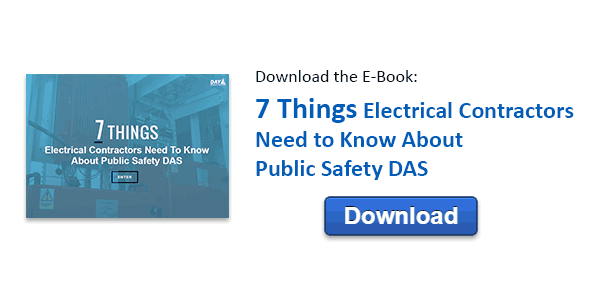I recently had a discussion with our DAS (Distributed Antenna Systems) business manager. The following series of posts are excerpts of our conversation. Our conversation revolves around the requirement for Emergency Responder Radio Coverage in buildings (International Fire Code ICC Section 510) and National Fire Protection Association (NFPA 72). DAS systems along with signal boosters are used to provide first responder/public safety radio coverage in buildings and other structures.
Part 1 of 3
How much does a DAS cost? What are the things to consider when pricing out a DAS system?
DAS (Distributed Antenna System) costs depend on a few different things. The first thing is the frequency range whether it is VHF, UHF, or 700-800 MHz public safety. Cost is going to vary based on the frequency; if it is all of the above it is going to be much more expensive than just one of those frequency bands. 700-800 frequencies are usually the easiest to do therefore it is usually the least expensive. VHF/UHF is more complex and it’s going to raise the cost. And if you need cellular frequencies obviously that’s also going to raise the cost. It’ll rise significantly if you need to get the 4 carriers involved.
How would I know what frequencies I need to amplify when it comes to Emergency Radio Coverage?
That’ll be based on each city or AHJ (Authority Having Jurisdiction). If you are in the City of Portland they have a radio system and would have certain guidelines and frequencies. If you go out to the Beaverton or Hillsboro (Oregon) area it is going to be a completely different radio system. Completely different frequencies. As a DAS integrator, we stay up to date on the emergency radio coverage frequencies and fire code requirements for all the different cities and jurisdictions we operate in.
What about the building type? Do you see different complexities in say, condos vs a hospital?
There are a lot of variances with buildings. That’s definitely another factor that determines price. If you are dealing with a wood structure with regular windows (non-low-E) you might not need a DAS because the radio signal can penetrate very easily. But if you have concrete or steel or brick along with low-e windows it’s basically shielding the inside from the building from ever receiving radio signal. So you are definitely going to need a system for that. If you have underground parking in a structure you are definitely going to need a system.
You brought up something interesting in that you may not need a DAS system. So what would the process be like under this scenario… I’m breaking ground on a building and emergency radio coverage is in the fire code, but I don’t know if I’ll need a DAS or not. What is the process to test if a DAS is needed?
Basically, it’s almost impossible to test on greenfield new construction. Because most fire code says new construction 50,000 square feet or more needs a system if coverage isn’t already there — that’s what determines the DAS test. As the building is being built, once the walls are in, the windows and ceilings, we’ll do a preliminary test to see what the coverage is in the building. And they have to meet certain radio signal standards like: -95 db for 90% of the building, 99% of all stairwells and elevators, and other critical areas. We’ll go in and do a 20 or 40 grid test, breaking each floor into even squares and test signal strength in those squares and we’ll see if it meets the criteria for fire code or not. If it doesn’t then it will need a system. If it does then you are good to go. We can provide you a certification to give to the fire marshal.
What would be the first step for someone interested in learning more about DAS?
If you don’t know what you need the first part of it is calling an integrator and seeing whether you need a system or not. That test is going to decide everything. A lot of times we’ll be able to tell you right upfront if there’s underground parking, there’s not going to be any coverage down there. That’s a guaranteed system that is needed. Or we would come out and do some testing to see exactly where you would need a system and we would design accordingly. So the first thing would be to contact an integrator and figure out what to look for and we can basically do a design and put you in a spot where you are not worrying about putting a system in at the last moment because that will raises cost as well.
A big thing we run into often with construction companies is that they’ll wait until the last minute to do a DAS system because they think they won’t need it, or it won’t be enforced by the AHJ. And then it’ll be the day before occupancy and the fire marshal will say “Where’s your DAS?” and then you’ll be in trouble. If you end up doing that and running that risk, that’s a costly risk because in most cases you’ll need cat & cable pathways and a lot of times you have hard lid ceiling it’s not an easy thing to do once the ceilings are up. It’s better to put these systems in while planning for them up front than to ignore it and hope it goes away, and then pay for it in the end because the install costs are dramatically more if you have to cut through hard lid ceiling as opposed to putting it in before the ceilings go up.
Typically if you are looking at DAS systems can you comfortably throw out a price per square foot based on different categories?
It really does wildly depend. If you gave me a specific jurisdiction where I knew the frequencies and I know the building type I could tell you.
For instance in Portland, OR a low-e glass, steel structure, 100,000 sf I would probably budget about a buck a square foot for public safety.
That same 100,000 sf building in San Jose might be $200,000 for that same building. If you add cellular it could be $400,000. So it can really go from 50¢ per square foot up to $5.00 per square foot depending on all these different factors.
Want to learn more about DAS? Check out Part 2 and 3 of the interview.
Part 2: What is the Biggest Mistake Customers Make When Buying or Installing a DAS System?
Part 3: How to Spot Contenders vs Pretenders When It Comes To DAS Integrators?

